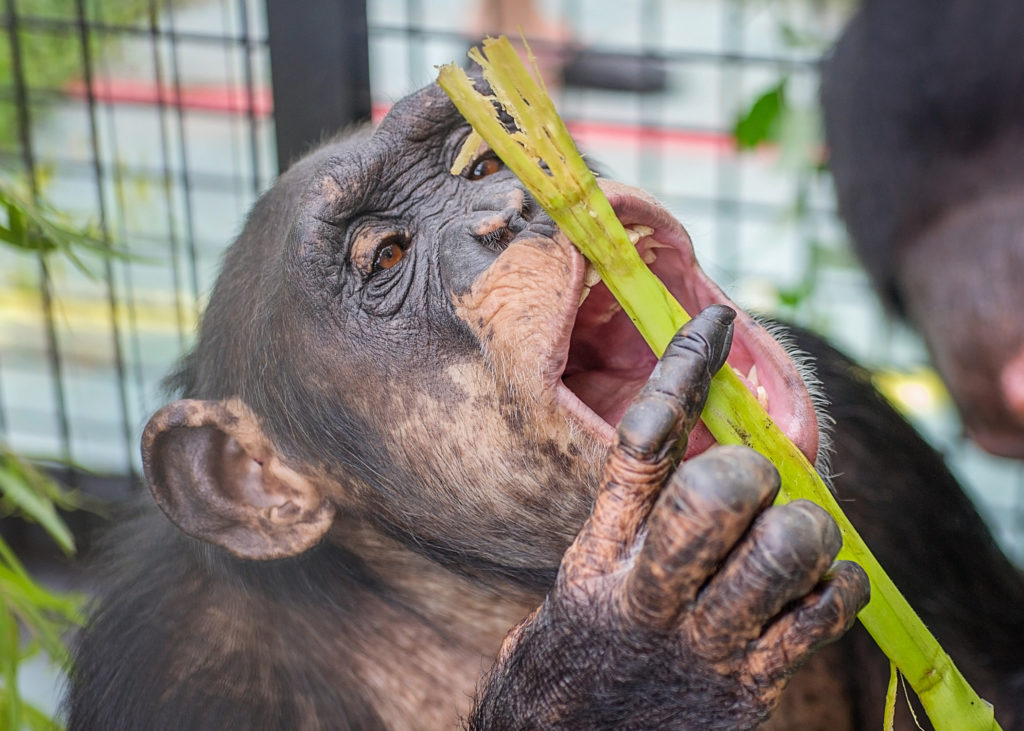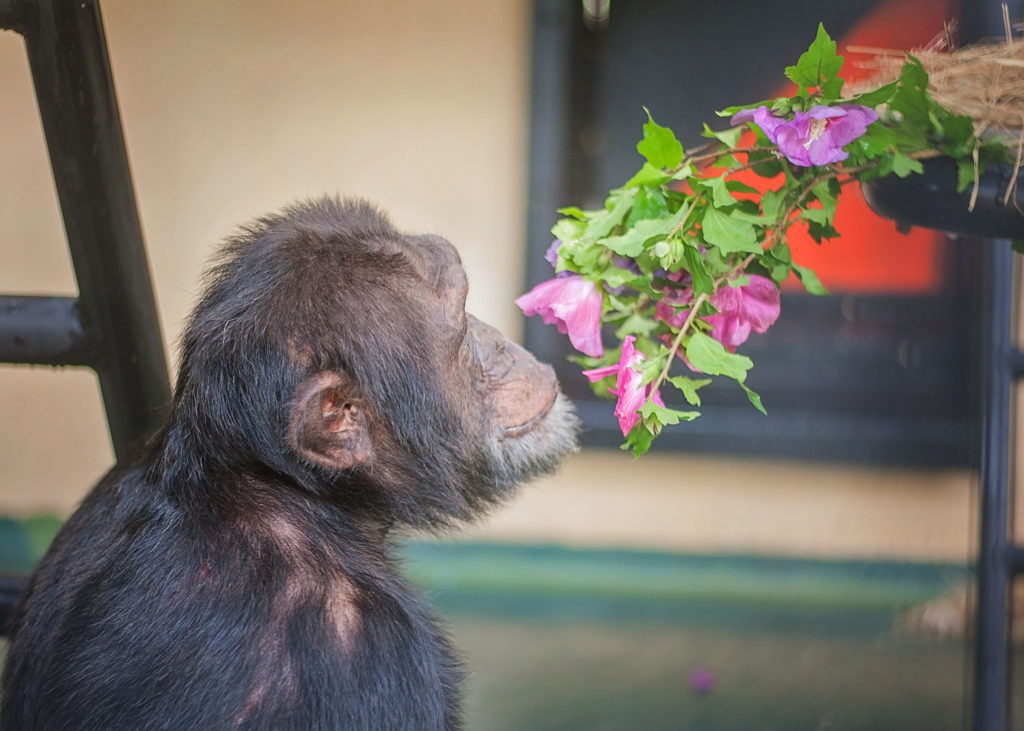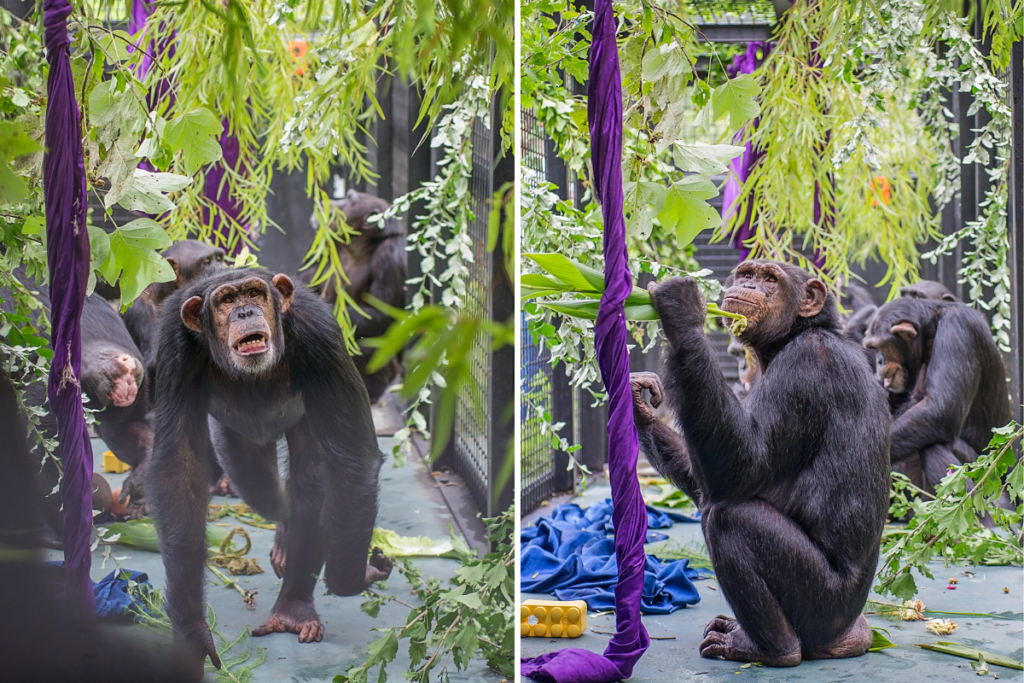
Former Research Chimps Browse the Menu in Sanctuary

At Project Chimps, we strive to enrich the lives of former research chimpanzees by giving them items that encourage their natural behaviors. In the wild, chimpanzees spend a majority of their day travelling and searching for food. Here at the Project Chimps sanctuary, our care team feeds the chimps a variety of fresh produce, the chimps don’t have to worry (like wild chimps would) where their next meal is coming from.
Browsing for tasty food items
In sanctuary, the chimps’ daily diet of fresh fruits and vegetables are supplemented with a variety of healthy “snacks” that the chimps have to search for. In the sanctuary world, we call it “browse” – leaves and branches from trees and plants that in the wild, chimpanzees would be searching for and munching on all day long.

Chimpanzee digestive tracks are designed to handle a good bit of fiber, so the benefit of browse for gut health is substantial. On top of hoping the chimps have happy bellies, browse also keeps the chimps occupied and challenged.
Members of our team gather stems and branches from both native plants and invasive plants that grow on the grounds of our sanctuary in the Blue Ridge Mountains of north Georgia. Chimpanzee caregivers then lay the cut branches on the tops of the mesh of the chimps’ large group enclosures so the chimps must pull the leaves through the mesh to eat, mimicking the foraging process in the wild. Once they get the leaves and branches, the chimps pick off parts they like, another time consuming process.
The chimpanzee eats shoots and leaves
After the leaves have been stripped and eaten, the chimps aren’t done. They can carefully use the sticks to manipulate one of their human-crafted puzzle feeders to get to the food inside or maybe they can hand the stick to one of their caregivers so the caregiver can use it to give them a little tickle.
Each chimpanzee has his or her own personality and interest in browse. Some may eat the plant material and some may not. Some chimps are interested in only certain types, others might eat it all.

What’s all that green stuff?
When new chimpanzees arrive to start their lives at Project Chimps, it is fun to watch their reactions to new browse plants. The plants might sit untouched until care staff need to remove it from the enclosure. We continue to offer fresh plants until one day a branch will be found stripped of its leaves or maybe a branch will be found sticking out of a tube that had peanut butter inside. Finally, the chimps are using their browse! Our caregivers have also seen the chimpanzees incorporate branches and leaves into their nightly nests.
A big hit with the chimps
In our experience, fresh browse is a hit with most of the chimps and a very important part of their daily enrichment. We are fortunate that a few types of native and non-native edible trees and shrubs grow on our property such as sourwood, willow, sweet gum, and bamboo, just to name a few.
Many of these plants grow naturally inside our 6-acre Peachtree Habitat and are quickly foraged by the chimps who choose to go outdoors. Many are also considered invasive, so we’re happy to prune them to keep them at bay.

Expanding the menu
To supply our growing population of chimpanzees with fresh browse as well as to ensure variety, we will continue to expand our sanctuary browse gardens throughout our property. That way, established trees and shrubs can be cut by staff and volunteers and delivered daily to the chimpanzee villas and the outdoor habitat – fresh and ready for them to enjoy!
To support foraging activities like this for former research chimpanzees, make a one-time or recurring donation to Project Chimps today.
